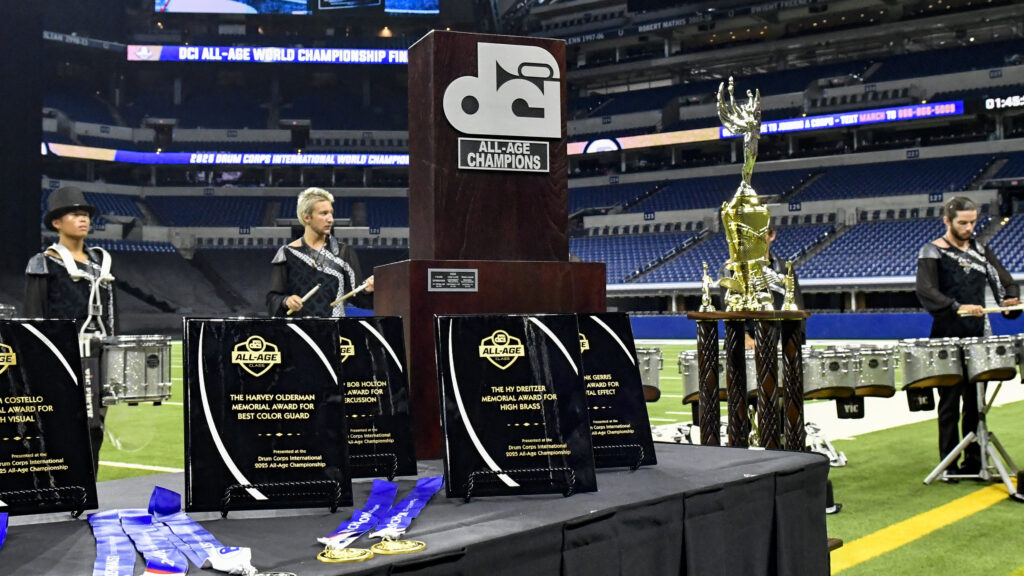
The Drum Corps International World Championships first went to Buffalo/Orchard Park, N.Y. for the first time in 1990, in what was then known as Rich Stadium. The big show returned to the renamed Ralph Wilson Stadium in 1995. Despite losing to the Blue Devils all four times the corps met prior to the last week of the season, and losing to the fourth-place Madison Scouts seven times, the Cavaliers won all three of the final shows of the summer to win their second DCI Championship title. Colts finished in ninth place, the corps’ highest DCI placement ever. The show, “Sunday Afternoon in the Park With George,” was based on the musical, “Sunday in the Park With George,” which took its cues from the famous painting, “A Sunday Afternoon on the Island of La Grande Jatte” by French pointillism master, Georges Seurat. The painting was created over a period of two years between the first sketches in 1884 and its completion in 1886, just five years before Seurat died at the age of 31 from a disease that was never firmly established. The setting of the painting is a Parisian riverside park, in which the artist spent months creating sketches for the final work, which is about 7×10 feet in size. In 1924, the Art Institute of Chicago purchased the artwork and it has since become one of the most visited paintings in the world. The painting drew the attention of Stephen Sondheim, who got his taste for musical theater as childhood friends with the son of the famed lyricist, Oscar Hammerstein II. Hammerstein became his mentor and provided him with invaluable constructive criticism, and also became somewhat of a surrogate father after Sondheim’s parents divorced when he was 10 years old. When he was 25 years old, he was introduced to Leonard Bernstein, who admired his work despite its near-total obscurity. Bernstein asked him to write the lyrics for “West Side Story,” the 1957 Broadway musical that became a smash hit and was later turned into a hit film. Sondheim went on to write lyrics for numerous Broadway hits and has since won eight Tony Awards, an Academy Award, eight Grammy Awards and a Pulitzer Prize, the latter for his 1984 Broadway musical upon which the Colts based their 1995 show. Colts’ production began with “Sunday in the Park With George,” a piece from Act I in the musical that touched on the frustrations of Dot, Seurat’s fictionalized longtime mistress and model whose name in real life was Madeleine Knobloch; the name Dot is an apparent joke about pointillism. The five-note figure that opened the show in the front ensemble percussion section was a recurring motif in the musical, the origin for more than one melody. The flags were black and white, as Seurat hadn’t yet begun to add color to his sketches. The color guard’s formalwear was solid black.
The next piece was “Children and Art” from Act II. The musical has jumped 100 years to 1984, when George and Dot’s great-grandson—also an artist named George—was unveiling an extremely modern work at a museum. After all others had left the unveiling, Marie (the daughter of the original George and grandmother of the current George) meditated on her legacy. Subtle blues and green from the sky and grass of the painting made it onto the flags, leading toward the completion of the artwork. The piece ended in a stylized heart, which could be interpreted many different ways. The following segment of the show was “Color and Light” from Act I. In the musical, Seurat was working on his painting while Dot was getting ready to go out for a night of entertainment. However, the painter decided to stay in and work on his painting, which gave Dot reservations about their doomed relationship. On the field, some of the color guard members revealed red tops amidst percussion sounds that played off the pointillism of the painting. Rather than drawing out the sound from the keys of the mallet keyboards as is typically done, these sounds were accomplished by the keyboard players depressing their mallets into the keys upon hitting the notes, creating a staccato effect. Blue flags and yellow rifles added to the palette, as color was added to the corps’ evolving musical canvas. One of the most captivating effects in the show was when the drummers played their drumheads with their hands. Though you can’t see it in the accompanying video clip, you’ll hear the bass drummers doing so at the end of the segment. Audience members had been trained by the end of the summer to be totally quiet in order to hear and appreciate the effect.

Colts’ closer was the ballad “Sunday” from Act I. In the musical, all the characters in the park scene were vigorously arguing, until Seurat took charge of everyone and successfully moved them into position for the painting. All sang in harmony, tranquility was restored, and a masterpiece was born. The brass players fell into a company front among flags of solid green (in front of the field as if grass) and flags of solid blue (in back of the field as if the sky). The front evolved into a giant horn arc—with the guard members splitting the arc with a large block triangle—and then that opening five-note theme in the mallets reappeared. The show ended quietly, the final gentle chord from the horns creating a sense of repose. The brass players and percussionists formed a giant square representing the frame of Seurat’s painting, and the rest of the painting and all it represents was left to our own artistic imaginations.
For this week only, you can save on the Legacy Collection DVD that contains this complete Colts performance, along with all finalists from the 1995 DCI World Championships.
Buy the 1995 Legacy Collection DVD. (Available this week only for 20% off. Regular price: $35.99.)
1995 Overview
Discount DVD offer ends Monday, June 16

Michael Boo was a member of the Cavaliers from 1975-1977. He has written about the drum corps activity for more than a quarter century and serves as a staff writer for various Drum Corps International projects. Boo has written for numerous other publications and has published an honors-winning book on the history of figure skating. As an accomplished composer, Boo holds a bachelor's degree in music education and a master's degree in music theory and composition. He resides in Chesterton, Ind.





